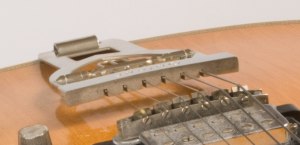There are many kinds of guitars, which I’m sure you know. However, the electric-acoustic-classical scale is not the only way of distinguishing them.
Guitar world has much more to offer, so today we’re going to give a quick look at archtop and flat-top guitars.
Archtop guitars

The name “archtop” has been given based on the shape that the body of a guitar has (the top and the back). So in essence, the most recognizable trait of these kind of guitars is their arched body (like you can see on the example above).
Another characteristic elements are: a moveable adjustable bridge (image below), F-shaped holes in the body (similar to a violin), and some Humbucker pickups in case of a semi-acoustic guitar.

To be honest, the terms “flat-top” and “archtop” may also refer to electric guitars. In essence, they don’t define the precise type of a guitar, only the shape of its body. However, most commonly when referring to an “archtop guitar” you are speaking about a semi-acoustic.
Apart from the pickups, the instrument looks more like an acoustic guitar than an electric guitar. The neck is similar in width to an acoustic, and it has a 14th-fret neck join.

When it comes to body, for high end models it’s carved out of a single block of wood, for cheaper solutions it’s heat-pressed. The F-shaped holes are based on similar solutions in violins and look almost exactly the same.
These kind of guitars are particularly valued by blues and jazz musicians. Originally, they’ve played them using some heavy strings to enhance volume. Since guitars became semi-electric there’s no need to do this now, but it still improves the tone nonetheless.
Some producers also use the terms flat-top and archtop to describe their acoustic, electric or even bass guitars. So you may stumble upon a Gibson Les Paul referred to as an archtop even though it has a solid body.
So in the end, I guess the best way of understanding what an archtop is, is to look only at the body. If it’s arched, it’s an archtop, as simple as this.
Flat-top guitars
I’m sure you kind of expecting this by now, but anyway – a flat-top guitar is a guitar with a flat body (the top and the back).
This term too is most often used to describe acoustic guitars, but some manufacturers use it for their electric and bass guitars as well.
To give you an easy reference – a flat-top guitar is your normal, everyday acoustic (or classical) guitar (image below).

The construction of the instrument varies a lot between different models. Manufacturers build their guitars out from many different materials and combinations of materials.
These flat-top guitars are usually the starting points for many beginner guitarists. A quality flat-top guitar is usually cheaper than its archtop friend.
There’s a lot I could say about this, but to be honest, I find it a little boring to continue with the construction and historical details. If you’re interested, however, go to Wikipedia for more info.
Example archtop and flat-top guitars
Archtop guitars:
- Epiphone Dot Studio Archtop Electric Guitar,Worn Vintage Sunburst
- Epiphone Joe Pass Emperor II Archtop Electric Guitar, Natural
- Godin 5th Avenue Archtop Jazz-Style Acoustic Guitar (Cognac Burst)
- Gibson Custom ES-335 Dot Electric Guitar, Vintage Sunburst, Plain Maple
Flat-top guitars:
- Epiphone DR-100 Acoustic Guitar, Vintage Sunburst
- Yamaha FG700S Acoustic Guitar
- Fender FA-130 Acoustic-Electric Guitar Pack, Black
- Fender CD-60CE Dreadnought Acoustic-Electric Guitar, Black
That’s it for today, I hope you enjoy this short post. Feel free to comment and share your own insights and interesting facts on archtop and flat-top guitars.









Guitar Headphone Amp
December 9, 2011 — 5:59 pm
Nice looking guitar reminds me of my father’s old Mexican style guitar. what i like about them is there stingy sound. when you them it really feels like your in Spain or somewhere exotic
Carlos
December 14, 2011 — 1:20 am
Quite recently I’ve been to Turkey, they have some really cool instruments there too. Unfortunately, I don’t remember the name…